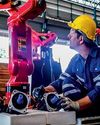
It has started a conversation around what the confines of the technology should be and how much impact this will have on people's jobs and livelihoods.
While similar to the conversation surrounding robots taking over certain duties, the AI conversation is very interesting because the battleground isn't necessarily what physical work could be taken over but what logical or cerebral work can be accomplished by AI.
Many commercials and fun videos have shown the harmonious union between people and technology to perform all sorts of tasks. Robot dogs dancing to music and sarcastic software giving Tony Stark a hard time are examples of how culture is beginning to anthropomorphize tools that are more sophisticated than what weare used to. Robots aside, AI is continually being scrutinized as to whether it is sentient or able to display emotion, or in some cases, forcing the question of what emotions or feelings truly are.
The Impact of Artificial Intelligence
Outside of students using Chat GPT to write their homework (or consultants using it to write their articles), how useful is this technology? Let's take it a step further and ask, how will this impact industry, and specifically, how will this impacta Lubrication Technician's daily work? To best answer these questions, we must first understand the typical work of a Lube Tech.
Lubrication is a skilled trade requiring specialized training and tools to perform it correctly. Sometimes this work is shared across multiple parties, such as maintenance, reliability, and operations, and sometimes it is designated to a single team. Regardless of how it is staffed, the work has to be completed in an optimal manner to ensure that the machine operates effectively and reliably, all while extending the component's life.
Let's start by looking at the normal activities within a typical lubrication program.
この記事は MACHINERY LUBRICATION INDIA の January - February 2024 版に掲載されています。
7 日間の Magzter GOLD 無料トライアルを開始して、何千もの厳選されたプレミアム ストーリー、9,000 以上の雑誌や新聞にアクセスしてください。
すでに購読者です ? サインイン
この記事は MACHINERY LUBRICATION INDIA の January - February 2024 版に掲載されています。
7 日間の Magzter GOLD 無料トライアルを開始して、何千もの厳選されたプレミアム ストーリー、9,000 以上の雑誌や新聞にアクセスしてください。
すでに購読者です? サインイン

The Secrets For Implementing A Clean lubricant Program
If you could find an investment that guaranteed a return 40 times greater than your initial investment, you probably wouldn't pass it up.

MAINTAIN? REPAIR? REPLACE?
When considering the life of any asset, the question arises: what types of interventions should be planned to keep it operating or to restore operation in the event of its failure?

Engineering Reports Should Be Like Bad Movies
I'm frequently asked to review engineering reports, and I'm continually baffled by how many engineers want to take their readers on a journey instead of getting to the point.

WHY SCHEDULED OIL CHANGES AREN'T ENOUGH TO MITIGATE LUBRICANT CONTAMINATION
There are few problems more insidious or damaging to large industrial machinery than contaminated lubricant.

LUBRICATION CONTAMINATION PREVENTION
How many articles have you read, or seminars listened to, that tout the value of contamination control? If you are like me, they number in the hundreds—if not thousands. One thing about these articles and seminars that bothers me is the word “control”.

LUBRICANT CONTAMINATION PREVENTION AND MITIGATION: A Guide For Maintenance Professionals
Lubricants are essential for the smooth and efficient operation of many types of machinery, from engines and turbines to gears and bearings.

TASK-BASED TRAINING | INSPECTING A SINGLE-POINT LUBRICATOR
A single-point lubricator is a device engineered to attach to a single unit to regularly and automatically deliver a small amount of clean grease or lubricating oil to a specific area.

TOP LEADERSHIP FOCUSES FOR IMPROVED RELIABILITY AND COST REDUCTION
Here’s a scenario that may sound eerily familiar – you have a new reliability initiative.

4 KEY ELEMENTS FOR INTERPRETING AN OIL ANALYSIS REPORT
Years ago, a customer came into my office, visibly upset. He had just received his second oil analysis report for one of his Caterpillar gas engines.

ASTM ENHANCEMENTS TO MICROSCOPIC PARTICLE IDENTIFICATION AND DOCUMENTATION
In 1982, Daniel Anderson published his influential book, \"Wear Particle Atlas\", which describes, sizes, and classifies particles found in oil.